Cultivated Land Sustainable Use Evaluation from the Perspective of the Water–Land–Energy–Food Nexus: A Case Study of the Major Grain-Producing Regions in Quzhou, China
Abstract
:1. Introduction
2. Materials and Methods
2.1. Study Area
2.2. Data
2.3. Methods
2.3.1. Theoretical Analysis and Evaluation Framework
- (1)
- Theoretical Explanation of Cultivated Land Use from the Perspective of the WLEF Nexus
- Element
- Structure
- Function
- (2)
- Evaluation Framework
2.3.2. Element Coordination
- (1)
- Evaluation Indicators of Element Coordination
- (2)
- Evaluation Methods of Element Coordination
2.3.3. Function Trade-Off
- (1)
- Evaluation Indicators of Function Trade-Off
- (2)
- Evaluation Methods of Function Trade-Off
3. Results
3.1. Changes in the Element Coordination of Cultivated Land Use in Quzhou County
3.1.1. Changes in the Comprehensive Development Level
3.1.2. Changes in the Element Coordination Degree
3.2. Changes in the Function Trade-Off of Cultivated Land Use in Quzhou County
3.2.1. Changes in the Function Index
3.2.2. Changes in the Trade-Off Degree
4. Discussion
5. Conclusions
Author Contributions
Funding
Data Availability Statement
Acknowledgments
Conflicts of Interest
References
- Bruinsma, J. The Resources Outlook: By How Much Do Land, Water and Crop Yields Need to Increase by 2050. In Expert Meeting on How to Feed the World in 2050; FAO: Rome, Italy, 2009. [Google Scholar]
- Al-Saidi, M.; Elagib, N.A. Towards understanding the integrative approach of the water, energy and food nexus. Sci. Total Environ. 2017, 574, 1131–1139. [Google Scholar] [CrossRef] [PubMed]
- Mohtar, R.H. The WEF Nexus Journey. Front. Sustain. Food Syst. 2022, 6, 820305. [Google Scholar] [CrossRef]
- Mohtar, R.H.; Daher, B. Water-Energy-Food Nexus Framework for facilitating multi-stakeholder dialogue. Water Int. 2018, 41, 655–661. [Google Scholar] [CrossRef]
- Ringler, C.; Bhaduri, A.; Lawford, R. The nexus across water, energy, land and food (WELF): Potential for improved resource use efficiency? Curr. Opin. Environ. Sust. 2013, 5, 617–624. [Google Scholar] [CrossRef]
- Gonzalez-Salazar, M.A.; Venturini, M.; Poganietz, W.; Finkenrath, M.; Kirsten, T.; Acevedo, H.; Spina, P.R. A general modeling framework to evaluate energy, economy, land-use and GHG emissions nexus for bioenergy exploitation. Appl. Energy 2016, 178, 223–249. [Google Scholar] [CrossRef]
- Siciliano, G.; Rulli, M.C.; D’ Odorico, P. European large-scale farmland investments and the land-water-energy-food nexus. Adv. Water Resour. 2017, 110, 579–590. [Google Scholar] [CrossRef]
- Van den Heuvel, L.; Blicharska, M.; Masia, S.; Sušnik, J.; Teutschbein, C. Ecosystem services in the Swedish water-energy-food-land-climate nexus: Anthropogenic pressures and physical interactions. Ecosyst. Serv. 2020, 44, 101141. [Google Scholar] [CrossRef]
- Sang-Hyun, L.; Makoto, T.; Rabi, H.M.; Jin-Yong, C.; Seung-Hwan, Y. An Analysis of the Water-Energy-Food-Land Requirements and CO2 Emissions for Food Security of Rice in Japan. Sustainability 2018, 10, 3354. [Google Scholar]
- Venghaus, S.; Märker, C.; Dieken, S.; Siekmann, F. Linking Environmental Policy Integration and the Water-Energy-Land-(Food-)Nexus: A Review of the European Union’s Energy, Water, and Agricultural Policies. Energies 2019, 12, 4446. [Google Scholar] [CrossRef]
- Namany, S.; Al-Ansari, T.; Govindan, R. Sustainable energy, water and food nexus systems: A focused review of decision-making tools for efficient resource management and governance. J. Clean. Prod. 2019, 225, 610–626. [Google Scholar] [CrossRef]
- Foran, T. Node and regime: Interdisciplinary analysis of water-energy-food nexus in the Mekong Region. Water Altern. 2015, 8, 655–674. [Google Scholar]
- Chang, Y.; Li, G.; Yao, Y.; Zhang, L.; Yu, C. Quantifying the water-energy-food nexus: Current status and trends. Energies 2016, 9, 65. [Google Scholar] [CrossRef]
- Olsson, G. Water, energy and food interactions-challenges and opportunities. Front. Environ. Sci. Eng. 2013, 7, 787–793. [Google Scholar] [CrossRef]
- Khan, S.; Hanjra, M.A. Footprints of water and energy inputs in food production—Global perspectives. Food Policy 2009, 34, 130–140. [Google Scholar] [CrossRef]
- Guillaume, J.H.A.; Kummu, M.; Eisner, S.; Varis, O. Transferable principles for managing the Nexus: Lessons from historical global water modelling of Central Asia. Water 2015, 7, 4200–4231. [Google Scholar] [CrossRef]
- De Strasser, L.; Lipponen, A.; Howells, M.; Stec, S.; Brethaut, C. A methodology to assess the water energy food ecosystems nexus in Transboundary River Basins. Water 2016, 8, 59. [Google Scholar] [CrossRef]
- Kibaroglu, A.; Gursoy, S.I. Water-energy-food nexus in a transboundary context: The Euphrates-Tigris river basin as a case study. Water Int. 2015, 40, 824–838. [Google Scholar] [CrossRef]
- Keskinen, M.; Someth, P.; Salmivaara, A.; Kummu, M. Water-energy-food nexus in a transboundary river basin: The case of Tonle Sap Lake, Mekong River Basin. Water 2015, 7, 5416–5436. [Google Scholar] [CrossRef]
- Gulati, M.; Jacobs, I.; Jooste, A.; Naidoo, D.; Fakir, S. The water-energy-food security nexus: Challenges and opportunities for food security in South Africa. Aquat. Proc. 2013, 1, 150–164. [Google Scholar] [CrossRef]
- Smajgl, A.; Ward, J.; Pluschke, L. The water-food-energy nexus—Realising a new paradigm. J. Hydrol. 2016, 533, 533–540. [Google Scholar] [CrossRef]
- Li, Y. Security Evaluation of Water-Energy-Food Nexus System in China Based on Synergetic-Symbiosis Theory. Master’s Thesis, Shandong Agricultural University, Taian, China, 2020. [Google Scholar]
- Xiang, Y. Study on Water-Land-Food(WLF) Nexus in Northeast China. Ph.D. Thesis, Chinese Academy of Agricultural Sciences, Beijing, China, 2020. [Google Scholar]
- Zhou, L.M.; Xie, X.H.; Zhu, Z.D.; Wang, L.X.; Wu, J.Y. Input-output efficiency of agricultural resources based on the water-energy-food nexus. J. Agric. Resour. Environ. 2020, 37, 875–881. [Google Scholar]
- Peng, S.M.; Zheng, X.K.; Wang, Y.; Jiang, G.Q. Study on water-energy-food collaborative optimization for Yellow River basin. Adv. Water Sci. 2017, 28, 681–690. [Google Scholar]
- Feng, Y.Z. A study on the Coupled and Coordinated Development of Water-Energy-Food System—A Case Study of Four Provinces in the Huaihe River Basin. Master’s Thesis, Nanjing Forestry University, Nanjing, China, 2020. [Google Scholar]
- Zhao, L.S.; Liu, S.J.; Sun, C.Z. Study on coupling and coordinated development of water-energy-food security system in Yellow River Basin. Water Resour. Prot. 2021, 37, 69–78. [Google Scholar]
- Bi, B.; Chen, D.; Deng, P.; Zhang, D.; Zhu, L.Y.; Zhang, P. The evolutionary characteristics analysis of coupling and coordination of regional water-energy-food. China Rural Water Hydropower 2018, 72–77. [Google Scholar]
- Guo, J. The Abundance and Shortage of Regional Water Resource and Its Impacts on the Coupling and Coordination Degree of Water-Energy-Food Compound System. Master’s Thesis, Northwest A & F University, Yangling, China, 2019. [Google Scholar]
- Stucki, V.; Sojamo, S. Nouns and numbers of the water-energy-security nexus in Central Asia. Int. J. Water Resour. Dev. 2012, 28, 399–418. [Google Scholar] [CrossRef]
- Halbe, J.; Pahl-Wostl, C.; Lange, M.A.; Velonis, C. Governance of transitions towards sustainable development—The water-energy-food nexus in Cyprus. Water Int. 2015, 40, 877–894. [Google Scholar] [CrossRef]
- Sahina, O.; Stewarta, R.A.; Richardsb, R.G. Addressing the water-energy-climate nexus conundrum: A systems approach. In Proceedings of the 7th International Congress on Environment Modelling and Software, San Diego, CA, USA, 15–19 June 2014. [Google Scholar]
- Ju, X.W. Research on Sustainable Development of Water, Energy and Food in China Based on System Dynamics. Master’s Thesis, China University of Petroleum, Beijing, China, 2019. [Google Scholar]
- Mi, H.; Zhou, W. The system simulation of China’s grain, fresh water and energy demand in the next 30 years. Popul. Econ. 2010, 31, 1–7. [Google Scholar]
- Li, G.J.; Li, Y.L.; Jia, X.J.; Du, L.; Huang, D.H. Establishment and simulation study of system dynamic model on sustainable development of water-energy-food nexus in Beijing. Manag. Rev. 2016, 28, 11–26. [Google Scholar]
- Li, G.J.; Huang, D.H.; Li, Y.L. Water-energy-food nexus (WEF-Nexus): New perspective on regional sustainable development. J. Cent. Univ. Finance Econ. 2016, 12, 76–90. [Google Scholar]
- Bazilian, M.; Rogner, H.; Howells, M.; Hermann, S.; Arent, D.; Gielen, D.; Steduto, P.; Mueller, A.; Komor, P.; Tol, R.S.J.; et al. Considering the energy, water and food nexus: Towards an integrated modelling approach. Energy Policy 2011, 39, 7896–7906. [Google Scholar] [CrossRef]
- Allouche, J.; Middleton, C.; Gyawali, D. Nexus Nirvana or Nexus Nullity? A Dynamic Approach to Security and Sustainability in the Water-Energy-Food Nexus. In STEPS Working Paper 63; STEPS Centre: Brighton, UK, 2014. [Google Scholar]
- Du, G.M.; Chai, L.J.; Li, Y.H. Theoretical explanation and research framework of cultivated land use system. Prog. Geogr. 2022, 41, 1288–1299. [Google Scholar] [CrossRef]
- Xu, J.H. A Study on the Energy Use and Energy Efficiency of Grain Production—Empirical Analyse Based on DEA. Master’s Thesis, Zhejiang University, Hangzhou, China, 2011. [Google Scholar]
- Zhang, R. Study on the Relationship between Grain Production and Water and Energy in Ningxia. Master’s Thesis, Xi’an University of Technology, Xi’an, China, 2019. [Google Scholar]
- Zhong, W. Evaluation index system and evaluation of sustainable utilization of cultivated land in the southwest frontier mountain area. Chin. J. Agric. Resour. Reg. Plan. 2018, 39, 48–53, 217. [Google Scholar]
- Liu, Y.P. Analysis of Spatial and Temporal Variability and Sustainability Assessment of Arable Land System in Shandong Province. Ph.D. Thesis, Shandong Agricultural University, Taian, China, 2022. [Google Scholar]
- Lyu, X.; Peng, W.; Niu, S.; Qu, Y.; Xin, Z. Evaluation of sustainable intensification of cultivated land use according to farming households’ livelihood types. Ecol. Indic. 2022, 138, 108848. [Google Scholar] [CrossRef]
- Nie, Y.; Avraamidou, S.; Xiao, X.; Pistikopoulos, E.N.; Li, J.; Zeng, Y.; Song, F.; Yu, J.; Zhu, M. A Food-Energy-Water Nexus approach for land use optimization. Sci. Total Environ. 2019, 659, 7–19. [Google Scholar] [CrossRef]
- Al-Saidi, M.; Hussein, H. The water-energy-food nexus and COVID-19: Towards a systematization of impacts and responses. Sci. Total Environ. 2021, 779, 146529. [Google Scholar] [CrossRef]
- Raya-Tapia, A.Y.; Cansino-Loeza, B.; Sánchez-Zarco, X.G.; Ramírez-Márquez, C.; Ponce-Ortega, J.M. A systematic approach for assessing water, energy and food security during the COVID-19 pandemic: Case study of Mexico. Environ. Dev. Sustain. 2022. [Google Scholar] [CrossRef]
- Yin, C.; Pereira, P.; Hua, T.; Liu, Y.; Zhu, J.; Zhao, W. Recover the food-energy-water nexus from COVID-19 under Sustainable Development Goals acceleration actions. Sci. Total Environ. 2022, 817, 153013. [Google Scholar] [CrossRef]
- Hussein, H.; Ezbakhe, F. The Water–Employment–Migration nexus: Buzzword or useful framework? Dev. Policy Rev. 2023, 41, e12676. [Google Scholar] [CrossRef]
- Hamidov, A.; Daedlow, K.; Webber, H.; Hussein, H.; Abdurahmanov, I.; Dolidudko, A.; Seerat, A.Y.; Solieva, U.; Woldeyohanes, T.; Helming, K. Operationalizing water-energy-food nexus research for sustainable development in social-ecological systems: An interdisciplinary learning case in Central Asia. Ecol. Soc. 2022, 27, 12. [Google Scholar] [CrossRef]
- Zhang, F.; Cui, N.; Guo, S.; Yue, Q.; Jiang, S.; Zhu, B.; Yu, X. Irrigation strategy optimization in irrigation districts with seasonal agricultural drought in southwest China: A copula-based stochastic multiobjective approach. Agric. Water Manag. 2023, 282, 108293. [Google Scholar] [CrossRef]
- Kelly, T.D.; Foster, T.; Schultz, D.M. Assessing the value of adapting irrigation strategies within the season. Agric. Water Manag. 2023, 275, 107986. [Google Scholar] [CrossRef]
- Zhan, X.; Shao, C.; He, R.; Shi, R. Evolution and Efficiency Assessment of Pesticide and Fertiliser Inputs to Cultivated Land in China. Int. J. Environ. Res. Public Health 2021, 18, 3771. [Google Scholar] [CrossRef] [PubMed]
- Xie, S.; Feng, H.; Yang, F.; Zhao, Z.; Hu, X.; Wei, C.; Liang, T.; Li, H.; Geng, Y. Does dual reduction in chemical fertilizer and pesticides improve nutrient loss and tea yield and quality? A pilot study in a green tea garden in Shaoxing, Zhejiang Province, China. Environ. Sci. Pollut. Res. 2019, 26, 2464–2476. [Google Scholar] [CrossRef] [PubMed]
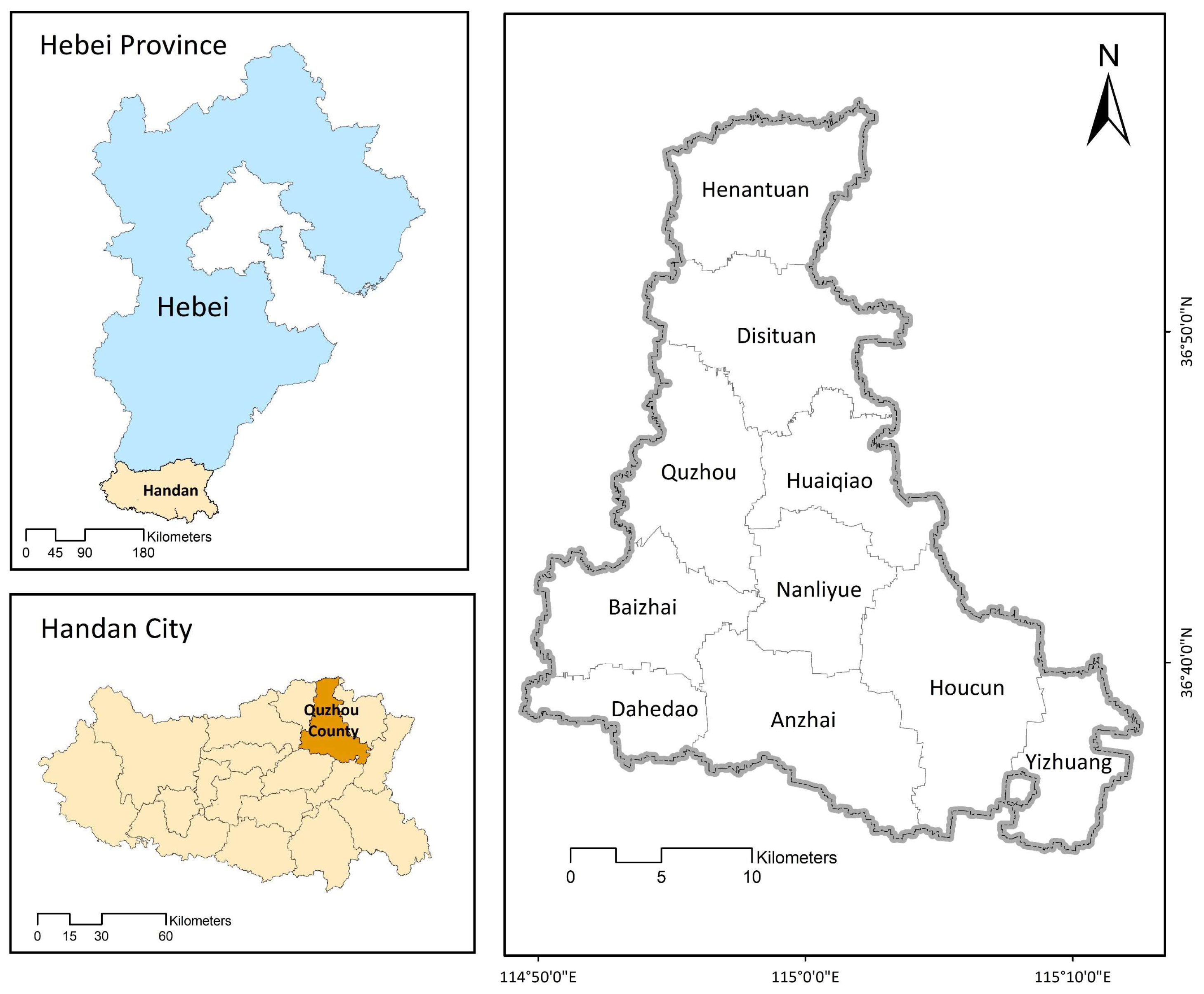
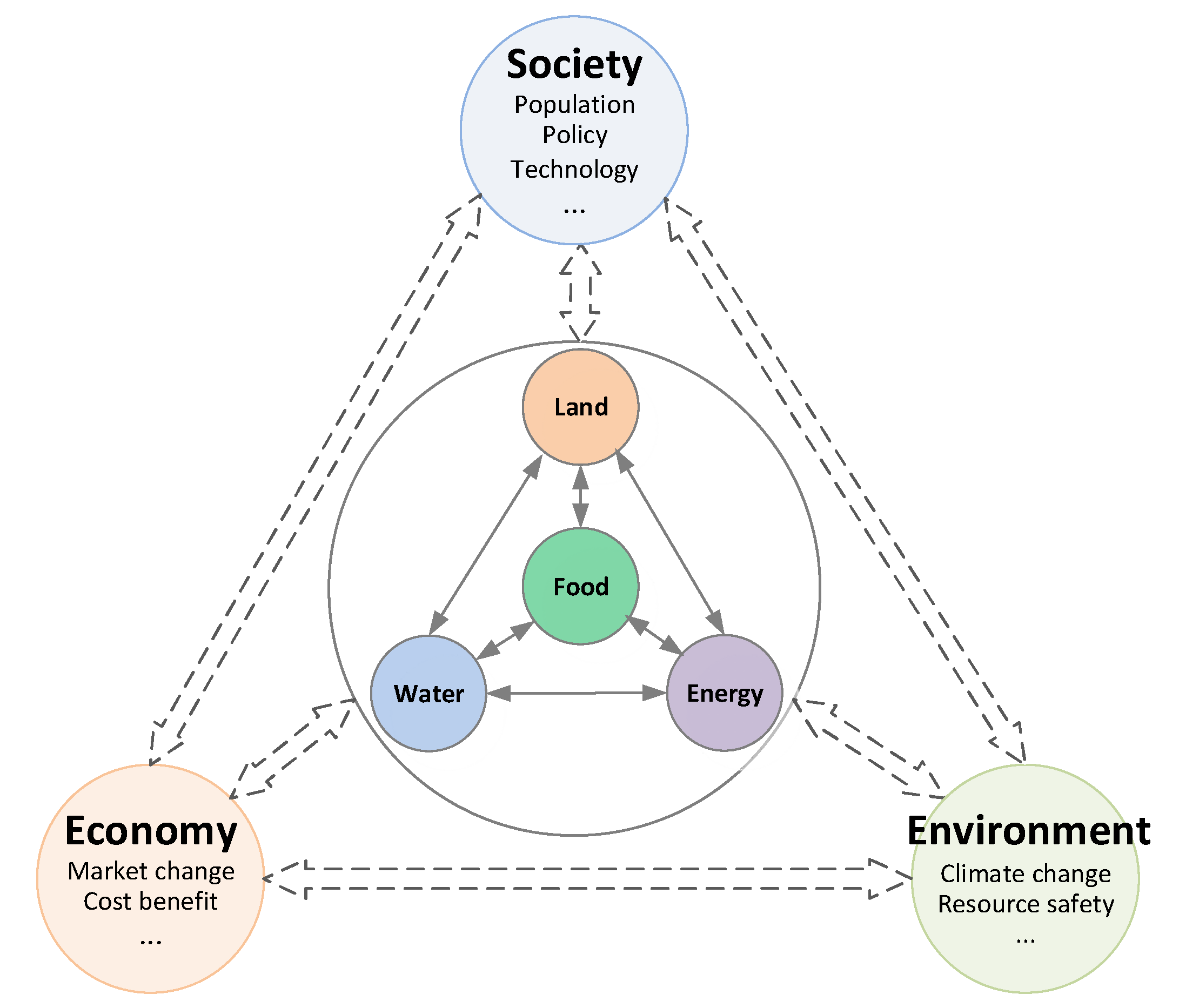
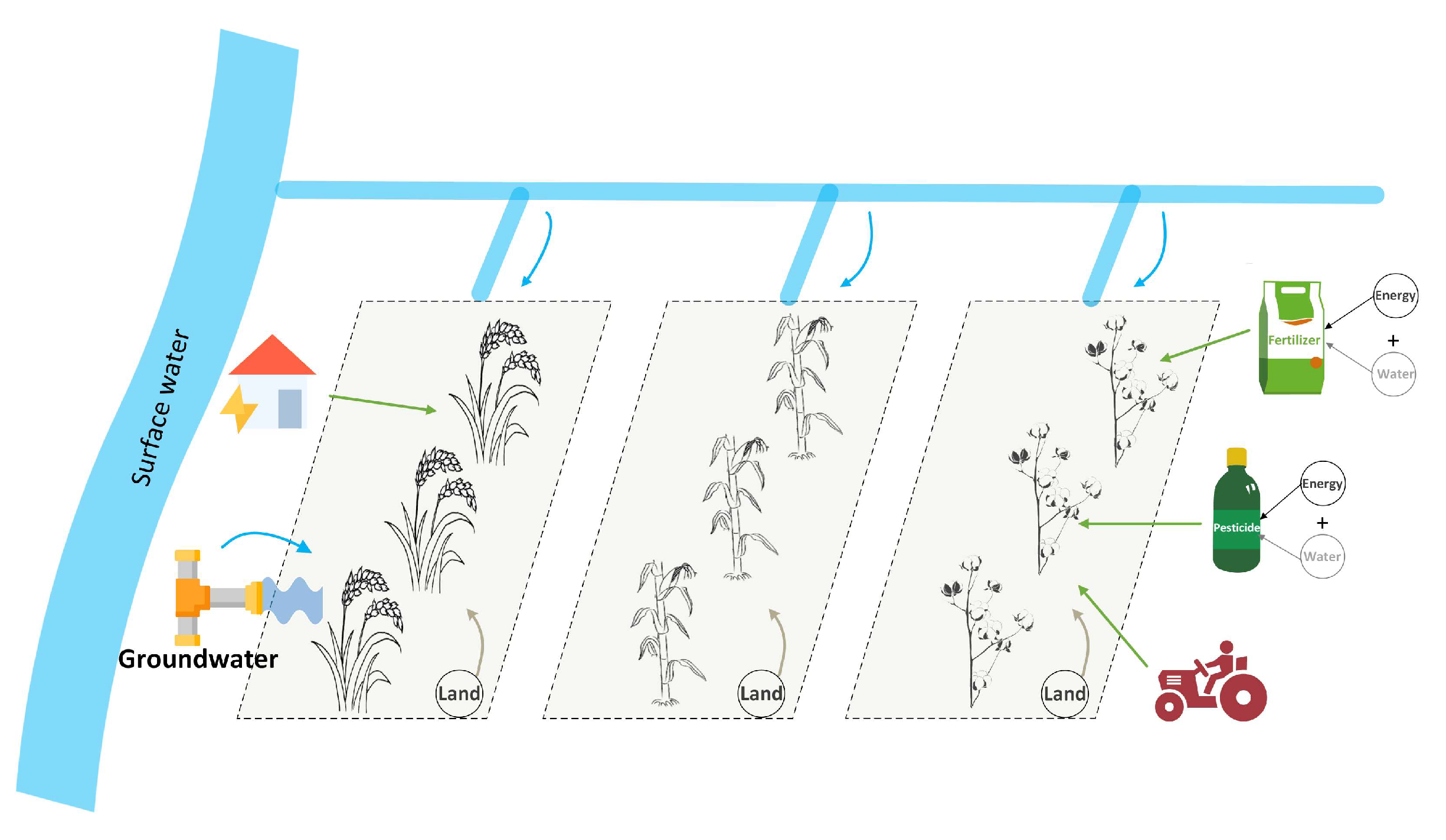


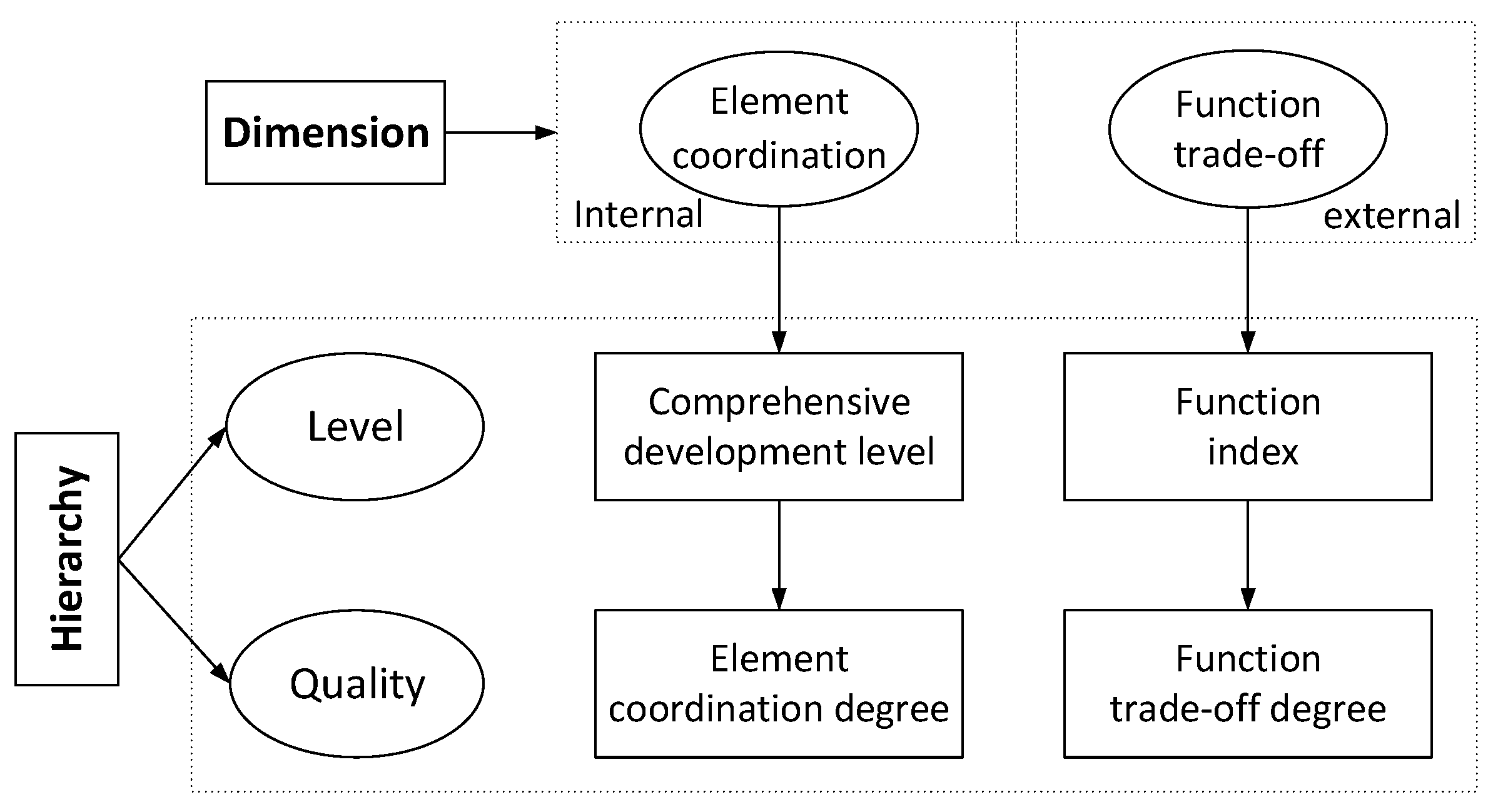



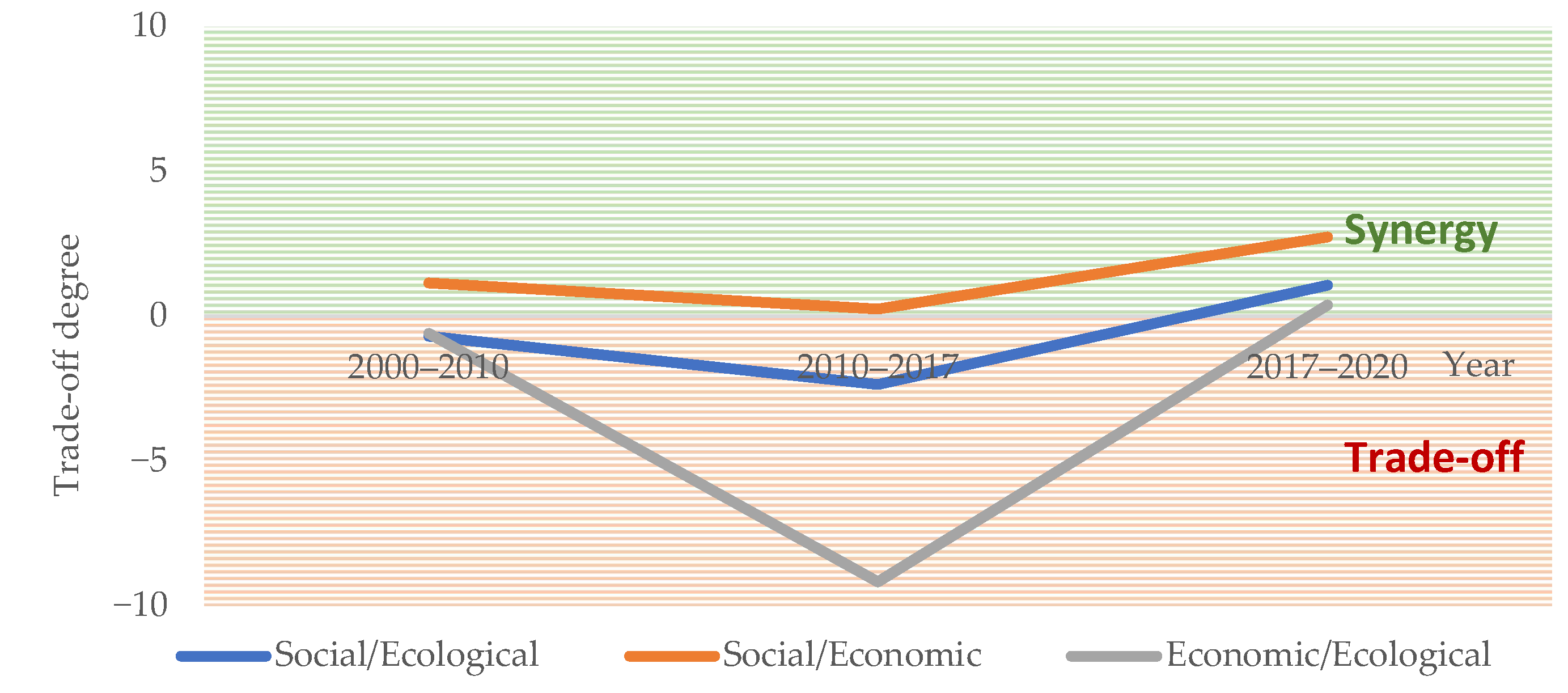
| Elemental Layer | Indicator Symbol | Indicator Name | Indicator Type |
|---|---|---|---|
| Water | A1 | Agricultural water use | Negative |
| A2 | Proportion of agricultural water use | Negative | |
| Land | B1 | Sown area of grain crops | Positive |
| B2 | Sown area of cotton | Positive | |
| B3 | Cultivated land area | Negative | |
| Energy | C1 | Energy consumption of agricultural diesel | Negative |
| C2 | Energy consumption of electricity | Negative | |
| C3 | Energy consumption of pesticide | Negative | |
| C4 | Energy consumption of fertilizer | Negative | |
| Food | D1 | Total grain output | Positive |
| D2 | Cotton output | Positive |
| Energy | Diesel | Electricity | Pesticide | Nitrogenous Fertilizer | Phosphate Fertilizer | Potash Fertilizer | Compound Fertilizer |
|---|---|---|---|---|---|---|---|
| Coefficients | 43.54 | 12.34 | 100.48 | 24.03 | 8.5 | 9 | 12.84 |
| The Comprehensive Development Level | 0–0.4 | 0.4–0.6 | 0.6–0.8 | 0.8–1 |
|---|---|---|---|---|
| Condition | Poor | Fair | Good | Excellent |
| Coordination Degree | 0–0.3 | 0.3–0.4 | 0.4–0.5 | 0.5–0.6 | 0.6–0.7 | 0.7–1 |
|---|---|---|---|---|---|---|
| Condition | Severely uncoordinated | Moderately uncoordinated | Slightly uncoordinated | Basically coordinated | Moderately coordinated | Highly coordinated |
| Element Layer | Indicator Symbol | Indicator Name | Indicator Type | Calculation Formula | Note |
|---|---|---|---|---|---|
| Social function | S1 | Per capita grain output | Positive | is the per capita grain output; is the total grain output; is the total population. | |
| S2 | Labor carrying capacity | Positive | is the labor carrying capacity; is the rural population; is the cultivated land area. | ||
| S3 | Comparative advantage index of grain output per unit area | Positive | is the comparative advantage index of grain output per unit area; is the grain output per unit area of Quzhou County; is the grain output per unit area of Hebei Province. | ||
| S4 | Comparative advantage index of cotton output per unit area | Positive | is the comparative advantage index of cotton output per unit area; is the cotton output per unit area of Quzhou County; is the cotton output per unit area of Hebei Province. | ||
| Economic function | En1 | Net profit of crop production | Positive | is the net profit of crop production; is the output value of crop production; is the cost of crop production. | |
| En2 | Contribution rate of agriculture | Positive | is the proportion of contribution rate of agriculture; is the gross domestic product of agriculture; is the total gross domestic product. | ||
| Ecological function | El1 | Total energy consumption | Negative | is the total energy consumption; is the energy consumption of agricultural diesel; is the energy consumption of electricity; is the energy consumption of pesticide; is the energy consumption of fertilizer. | |
| El2 | Proportion of agricultural groundwater use | Negative | is the proportion of agricultural groundwater use; is the groundwater use for agriculture; is the agricultural water use. | ||
| El3 | Net carbon sequestration | Positive | NC is the net carbon sequestration; is the carbon sequestration; is the carbon emission; is the carbon content of crop i; is the economic yield of crop i; is the moisture content of crop i; is the economic coefficient of crop i; is the root–shoot ratio of crop i; n is the types of the staple crops; n = 3; is the carbon emission of soil respiration; is the carbon emission of producing activities, including irrigation electricity, diesel, pesticide, and fertilizer; is the cultivated land area; is the annual soil carbon emission per unit area; is the consumption of irrigation electricity, diesel, pesticide, and fertilizer; is the carbon emission coefficient of each producing activity; m is the types of producing activities, m = 4. |
Disclaimer/Publisher’s Note: The statements, opinions and data contained in all publications are solely those of the individual author(s) and contributor(s) and not of MDPI and/or the editor(s). MDPI and/or the editor(s) disclaim responsibility for any injury to people or property resulting from any ideas, methods, instructions or products referred to in the content. |
© 2023 by the authors. Licensee MDPI, Basel, Switzerland. This article is an open access article distributed under the terms and conditions of the Creative Commons Attribution (CC BY) license (https://creativecommons.org/licenses/by/4.0/).
Share and Cite
Chen, A.; Hao, Z.; Wang, R.; Zhao, H.; Hao, J.; Xu, R.; Duan, H. Cultivated Land Sustainable Use Evaluation from the Perspective of the Water–Land–Energy–Food Nexus: A Case Study of the Major Grain-Producing Regions in Quzhou, China. Agronomy 2023, 13, 2362. https://doi.org/10.3390/agronomy13092362
Chen A, Hao Z, Wang R, Zhao H, Hao J, Xu R, Duan H. Cultivated Land Sustainable Use Evaluation from the Perspective of the Water–Land–Energy–Food Nexus: A Case Study of the Major Grain-Producing Regions in Quzhou, China. Agronomy. 2023; 13(9):2362. https://doi.org/10.3390/agronomy13092362
Chicago/Turabian StyleChen, Aiqi, Zhen Hao, Rong Wang, Hongli Zhao, Jinmin Hao, Ran Xu, and Hao Duan. 2023. "Cultivated Land Sustainable Use Evaluation from the Perspective of the Water–Land–Energy–Food Nexus: A Case Study of the Major Grain-Producing Regions in Quzhou, China" Agronomy 13, no. 9: 2362. https://doi.org/10.3390/agronomy13092362






